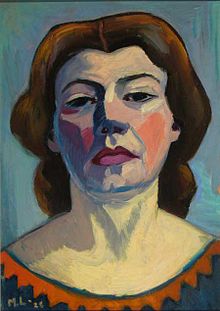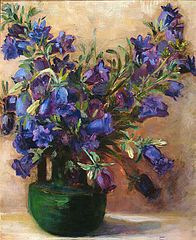Maggie Laubser, like her contemporary, Olive Schreiner, was a South African woman who pushed the boundaries further than could be expected of a Victorian woman living in remote South Africa, in the late 19th century.
Early Life
Laubser’s childhood, on a wheat farm in the Swartland, was idyllic. Born on the 14 April 1886, Maria Magdalena Laubser was one of six children. When not attending the local Rocklands farm school, she spent her free time roaming the veld on her pony and enjoying the vast, open spaces.
In 1897 she attended the Bloemhof Seminary in Stellenbosch where she received some art lessons but she had to leave in 1901, during the Anglo-Boer War, so that her brothers could attend school. At home once more she spent time doing pencil sketches, copying from postcards and photographs.
She began singing lessons in Cape Town but soon stopped in favour of art lessons from Prof. Edward Roworth. Between 1903-1908 she concentrated on seascapes, landscapes and still-life studies. Her work was of a sufficiently high standard to be included in the 1909 annual exhibition of the South African Society of Artists.
During those years, Laubser’s circle of friends included many of the Cape Town artists, for example Frans Oerder, Ruth Prowse, G.W.Pilkington and Hugo Naude. In 1912 Laubser took a post as governess to the Wolmarans family in the Ermelo district. Whilst living with the family, she continued sketching from postcards and photos and sold quite a few portraits of the South African war generals. She spent a holiday in Durban in 1912 and met her future mentor, Jan Hendrik Balwe, a successful businessman who, recognising her talent, offered to finance her overseas study.
Life Abroad
In 1913 Laubser went to Holland and settled in the artists’ colony of Laren, where she worked in the studio established by Anton Mauve (cousin-in-law of Vincent Van Gogh).
Early in 1914, when it seemed that war was imminent, Laubser left Holland and went to London where she enrolled in the Slade School of Art. It seems that her time in London and at the Slade was not a particularly happy period, for several reasons: England was at war; she was considerably older than the other students; her Colonial background was different from that of her fellow students and finally, she found the method of teaching at the Slade to be rigid and uninspiring. She stayed in London for the duration of the war and her paintings, during this period, were all done when she made private sojourns to the country, there she painted plein-air, the gentle countryside in suitably restrained colours.
After the War 1919-1924
In 1919 Laubser went to Italy on a painting holiday with Arnold Balwe (son of her mentor, J.H. Balwe). En route to Italy, they travelled through Germany, where Laubser was arrested in Munich for not having a visa. Although the matter was sorted out, her broken journey meant that she was able to see the work of some German artists which she had never seen before. She immediately responded to, and was enthralled by, the works of Kandinsky, Klee, Macke and Franz Marc, the founders of Der Blaue Reiter movement.
The paintings and sketches which Laubser did during that holiday in Italy, show a vibrancy and uninhibitedness which were lacking in her works during her Slade period; she might well have responded to the sense of freedom and immediacy which she’d seen in the works of those pre-war German Expressionist artists, while she’d been detained in Germany en route to Italy. Laubser herself admitted that that period spent at the Italian Lakes was one of the happiest times of her life.
She visited Italy again in 1921 and also returned to Cape Town for a visit in 1921, where she painted the pastoral scenes she so loved.
Germany
Laubser obtained a visa to visit Germany and in January 1923 went to live in Berlin. She met up with fellow South African artist Irma Stern and they developed a lasting friendship, both sharing similar ideas about art. Laubser soon immersed herself in the cultural life of Berlin, coming into contact with German Expressionism, the movement she’d so admired a few years earlier. However, she found that there was a distinct difference between the pre-war and post-war art trends in Germany. Post-war Expressionism had lost its earlier emotive force and affinity with nature and had embraced a type of cynical realsim which Laubser found difficult to embrace. Her affinity lay with the pre-war Expressionists and though she never admitted to having been influenced by them, she admired and identified with the movement.
Return to South Africa
In 1924 Laubser returned to South Africa, to her family home, near Cape Town. She sent one of her paintings to an exhibition in Cape Town in 1925 where it received harsh criticism. This type of criticism was to continue for a long while; she was labelled a ‘modernist’ and her pictures were thought to be outlandish. She retreated t0 the farm and rejuvenated her soul in the simple, everyday aspect of farm life and the solace of the surrounding countryside.
During this time she painted landscapes, scenes of labourers going about their work on the farm and domestic and farm animals – all were painted with her own inimitable style which she’d developed over the years. Gradually her work gained recognition amongst her peers, although she was still at the mercy of the critics. Her paintings began to appear in art catalogues and her still-life and paintings of fishermen’s cottages were admired and purchased.
Later Years
Laubser settled in Cape Town in 1937 and later built a cottage on the Strand, where she lived for the rest of her life. She travelled throughout South Africa on extended painting trips, painting the harvest landscapes which she so loved. By the 1940s she had become an accepted artist of note, mentioned in all the important art works published at the time. In 1946 she was awarded the Medal of Honour by the South African Academy of Art and Science and the Oscar Award for painting, a year later.
Laubser continued painting almost right up to her death – her greatest artistic achievements, however, were in the years 1922-1945. She died in 1973 and left a large legacy to the University of Stellenbosch, which established a trust fund in her name, to help deserving art students.
Laubser’s contribution to South African art is immense – she changed the way in which people viewed art – her paintings allowed people to view everyday scenes – animals, figures, flowers, people and landscapes – through her eyes and to enjoy the freshness, vibrancy and joy of each subject. She never allowed criticism to deter her from her own vision and her own sense of reality.
She was truly an artist extraordinaire and rightly deserves her place in the art hierarchy of South Africa and the rest of the world.

